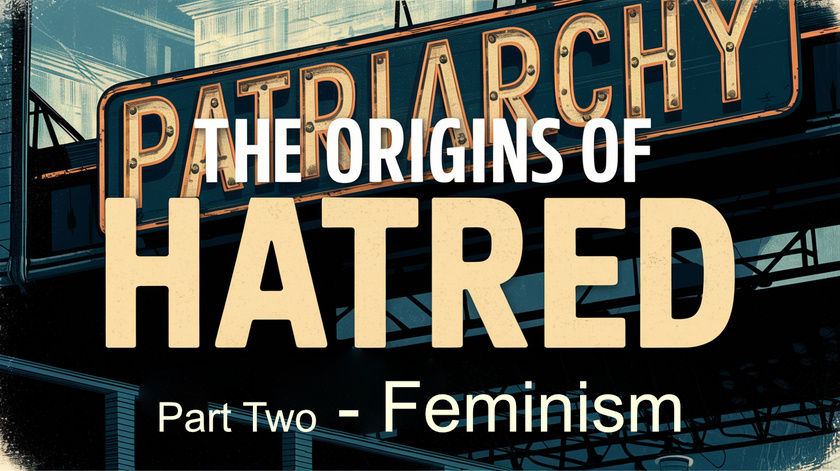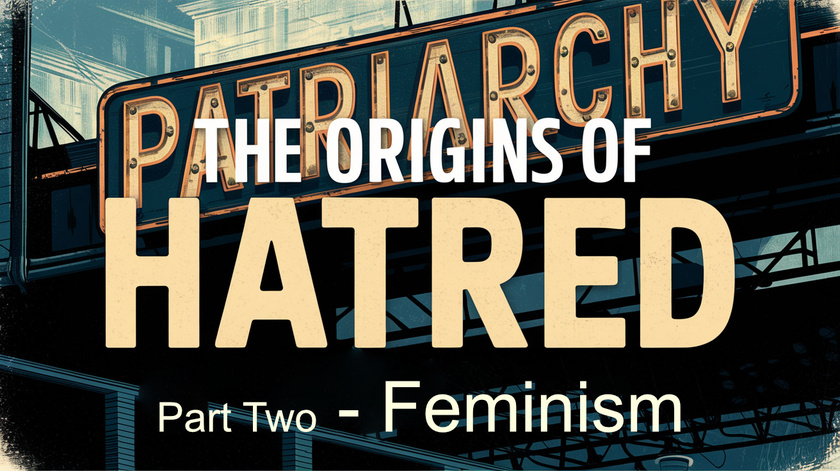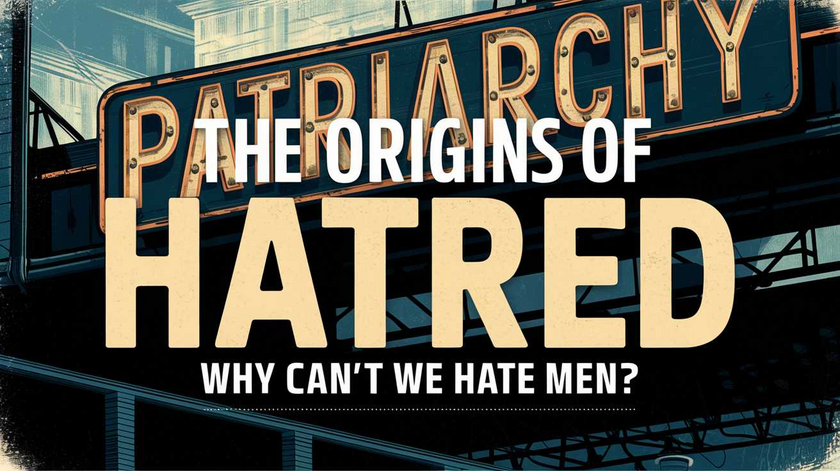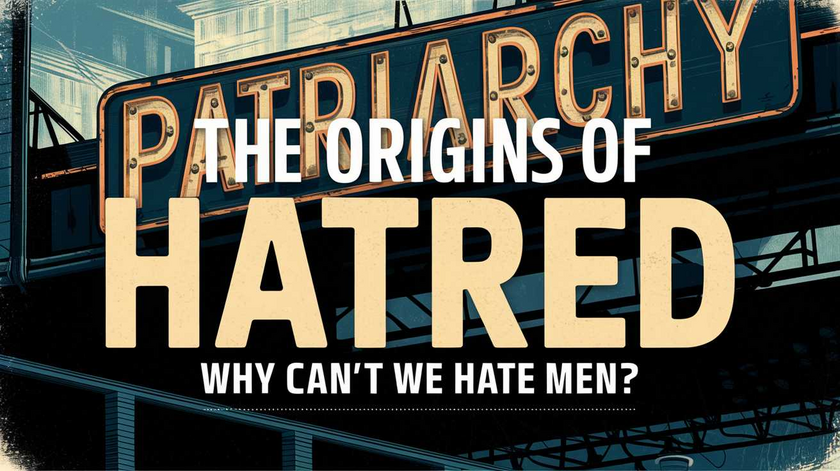
How Feminism Manufactured Fear and Distrust of Men
One of the clearest long-term examples of using fear, blame, victimhood, and resentment as a social tactic is the way feminism — backed by unwavering support from the media and lawmakers — has worked to embed fear, distrust, and blame into the minds of women and girls.
Nearly every major feminist campaign has been built on two themes: blaming men and claiming victimhood. Along the way, women have been encouraged to distrust men, to fear them, and to view their actions through a lens of suspicion.
The success of these campaigns has relied heavily on gynocentrism — a deeply embedded, often invisible bias. Most people don’t even realize they carry it, but it’s there, quietly shaping our instincts. Gynocentrism shows up as an automatic tendency to prioritize the needs, emotions, and concerns of women, while overlooking those of men. Feminists have strategically weaponized this bias, using it to pressure institutions and society into funneling more resources to women.
In the previous post, The Origins of Hatred, we discussed how hatred often grows out of fear, distrust, resentment, and the belief that something rightfully yours could be stolen. When these emotions are stirred up, the chances of hatred taking root rise dramatically.
We’ve seen the slogans — the t-shirts and mugs that proudly say things like “I bathe in male tears.” That’s not just casual humor; it’s celebrating the pain of men. And when one group openly relishes the suffering of another, that’s a serious warning sign of hatred.
Sometimes, the hatred isn’t even hidden. It was spelled out plainly in a Washington Post article by Walters titled "Why Can't We Hate Men?" No subtle hints, no veiled language — just a blunt statement: we deserve to hate men.
Over the years, there have been plenty of openly misandrist books too, including the infamous S.C.U.M. Manifesto by Valerie Solanas. (S.C.U.M. stands for Society for Cutting Up Men.) Sound like the name of a hate group to you? It should.
It’s not hard to see: some women have been led — even encouraged — to hate men.
Let’s take a closer look at how this has been done, step by step.
Inventing the Patriarchy Monster
The first move was to create a villain: Patriarchy. Feminists claimed this invisible, omnipresent system had stolen women’s rights and opportunities for centuries — and that all men were participants. It was portrayed as a global conspiracy designed by men to oppress women.
This narrative cast women as perpetual victims and men as perpetual perpetrators. If women were victims of this monstrous system, it gave them a reason to fear, distrust, and blame men for their problems. Crucially, it wasn’t just a handful of powerful tycoons being blamed — it was every man.
This conditioned women to view men not as allies or protectors, but as thieves of opportunity and freedom. And once fear and blame is planted, distrust follows. Over time, this distrust breeds resentment, and this can inevitably curdle into hatred.
Manufacturing Fear of Men’s Violence
Next, feminism relentlessly exaggerated the threat of male violence. Even though fewer than a half of 1% of men are convicted of violent crimes, men were collectively painted as dangerous.
Campaigns like “Take Back the Night” suggested that men had made public spaces unsafe. Anti-rape crusades pushed slogans like “All men are potential rapists.” Domestic violence campaigns implied that any woman, at any time, could be in danger from any man — despite data showing domestic violence is most prevalent in lower socio-economic groups and that men are victims too.
The aim was simple: fuel fear and distrust by promoting the idea that all men were potential threats. And history tells us what happens next: fear transforms into resentment, and unchecked resentment leads to hate. The more women were told to see men as unpredictable dangers, the more those emotions hardened.
Demonizing Masculinity Itself
As the fear campaigns intensified, a new weapon emerged: toxic masculinity. Feminists began to redefine traditional masculine traits—such as strength, stoicism, and competitiveness—as inherently harmful. The very qualities that had long been vital for protecting and providing for women and children were suddenly recast as dangerous and pathological.
Imagine the backlash if someone claimed femininity itself was toxic. But the “toxic masculinity” label stuck — widely accepted, even celebrated, in popular culture and media.
What message does this send women? That men, by their very nature, are dangerous. It discourages trust, closeness, and cooperation, and promotes out-group hostility — seeing men as outsiders and threats. Fear escalates, trust deteriorates, and resentment simmers just beneath the surface. Over time, that resentment metastasizes into outright hatred of not just specific men, but masculinity itself.
Reframing Male Help as Oppression
Another tactic was to portray even positive male behavior as suspect. Feminists argued that when men protect or help women, it’s about control and paternalism. Acts of chivalry were repackaged as disguised domination. Gratitude was replaced with skepticism, doubt, and fear.
This seeded doubt in women’s minds: Is his kindness genuine, or does he have an agenda? Over time, this isolated women further and disoriented men who suddenly found their supportive gestures met with suspicion. He found himself living in a world where he simply can't win.
And what follows when goodwill is viewed as manipulation? Fear. Distrust. Resentment. The natural progression plays out yet again: suspicion leads to bitterness, and bitterness makes way for hate.
All the while, traditionally masculine strengths like logic, fairness, and objective reasoning were increasingly dismissed or devalued. In their place, emotional expression and subjective feelings were elevated as the highest forms of truth. Rather than balancing reason and emotion, the cultural shift sidelined men's natural strengths, portraying them as cold, outdated, or even oppressive. The result was a climate where emotional narratives often trumped evidence, and fairness took a backseat to feelings.
Casting Relationships as Power Struggles
Feminists promoted the idea that heterosexual relationships are inherently imbalanced and exploitative. Men, they claimed, were constantly scheming to take women’s resources, power, and autonomy.
This worldview cast suspicion on romantic relationships and encouraged women to view partnerships not as mutual alliances, but as battles for dominance. The feminist cry was all sex is rape!
Once again: fear breeds distrust, which breeds resentment. And when the very idea of love and partnership is painted as a contest of control, hatred isn’t far behind. What should foster connection instead fosters division.
Creating a Media Echo Chamber
The media eagerly amplified these narratives. Stories of men as protectors, supporters, or victims rarely made headlines. Instead, article after article, news segment after news segment, depicted women as victims and men as perpetrators.
This one-sided portrayal conditioned the public to see male violence and male wrongdoing as the norm, while male victimhood was erased. Constant exposure to this selective narrative created a skewed perception of male behavior and fueled generalized fear.
And as with every other step: sustained fear morphs into distrust, distrust into resentment, and resentment into hatred. This is not an accidental outcome — it’s a predictable consequence of systematically vilifying one half of the population.
Spreading the Fear Template Across Issues
Feminism applied its fear-and-blame template to virtually every major social issue, consistently casting men as oppressors and women as victims. This narrative became the default lens through which public policy, media coverage, and cultural norms were shaped. Let's have a closer look a some of the issues.
The Domestic Violence Example
Perhaps the clearest example is domestic violence. Feminists claimed men were battering women in alarming numbers, and demanded government action. What they deliberately left out was that men, too, were victims — at comparable rates.
Prominent feminist Ellen Pence, a leader in the domestic violence movement, later admitted:
“In many ways, we turned a blind eye to many women’s use of violence, their drug use and alcoholism, and their often harsh and violent treatment of their own children.”
Yet for years, feminists successfully pushed a one-sided narrative, securing billions in funding for women-only services while erasing male victims. Male legislators, eager to prove they weren't the “enemy,” funded a women-only domestic violence industry—one that now commands nearly $5 billion a year in federal and state funding, despite its foundation being built on selective data and misleading claims. The result? A culture trained to see men as inherently dangerous and women as always innocent victims.
And where one group is painted as evil and the other as blameless, fear and distrust fester. Resentment builds. Hate is the inevitable consequence.
Education: Feminists claimed that the patriarchy had systematically cheated girls out of opportunity. Girls were portrayed as emotionally battered by a male-dominated system that ignored their needs. The solution? Re-engineer the educational environment to favor girls—by de-emphasizing competition, downplaying boys’ natural learning styles, and prioritizing emotional safety over academic rigor. The result has been a system where boys now lag behind in graduation rates, college enrollment, and literacy, but no one is rushing to fix it for them.
Reproductive Rights: The conversation was framed as a battle against male control of women’s bodies, summed up by the slogan: “Her body, her choice.” But while women were given full reproductive authority, men were given no rights, no say, and no support. The father's role was reduced to that of a bystander—unless child support was needed. There was no public outcry about this imbalance, only cheers for women's autonomy, and silence about male disenfranchisement.
Healthcare: Feminists claimed women were neglected by a healthcare system designed by and for men. They argued that women were left out of medical research and left out of research studies. These claims have since been debunked. There are eight federal offices for women's health and none for men. Just one of those offices for women got a budget for 2025 for nearly 1.5 billion dollars while men's offices got zero. They have also found that women actually use more healthcare services and live longer than men—but the narrative stuck, women need and deserve more. Men, meanwhile, still die younger, have fewer resources for gender-specific health issues, and are underrepresented in healthcare outreach. Yet somehow, the blame was again placed on men.
Divorce: Men were portrayed as abusive and emotionally stifling, while women were framed as desperate to escape. No-fault divorce arrived as the silver bullet, allowing women to end marriages unilaterally, often with financial gain and favorable custody arrangements. What kind of contract allows one party to walk away, take the kids, and still profit? It was a seismic power shift that disempowered men—especially fathers—and handed the upper hand to women under the guise of liberation.
Sexual Assault: The narrative became: All men are potential predators. Due process was seen as a barrier to "believing women." The fear-based messaging painted entire groups of men as suspect, regardless of evidence, while encouraging women to view every interaction through the lens of danger.
Pay Gap: Feminists accused men of deliberately underpaying women. Yet Warren Farrell has thoroughly debunked this myth, showing that the so-called “gap” is almost entirely due to life choices—career fields, hours worked, risk tolerance—not discrimination. Still, the blame stuck to men, and the myth continues to be used to justify gender-based policy and hiring practices.
Sexual Harassment: Men were framed as aggressors who silenced and intimidated women in the workplace. The blanket vilification of men created an atmosphere of suspicion, where normal workplace interactions could be reinterpreted as threats. Men’s natural ways of interacting — being competitive, giving blunt feedback, and adopting a “tough it out” mentality — were seen as harmful to women. But instead of encouraging women to adapt to this more demanding environment, the solution was to change the men.
Mansplaining: A new cultural buzzword emerged to shame men for speaking, especially when sharing knowledge. It wasn’t enough to disagree—men were now accused of "stealing women's voices" anytime they offered a perspective.
Manspreading: Even how men sit became political. Men were now “stealing women’s space” by taking up too much room on public transport. Masculine posture was reframed as a public offense.
The Result: A Culture of Fear, Distrust, and Hatred
By repeatedly following the same formula — false accusations, inflated victimhood, vilifying men, and demanding urgent action — feminism has succeeded in making women suspicious, fearful, and distrustful of men.
Women were placed in a difficult bind:
If you believe the narrative, you must fear men.
If you believe the narrative, you must distrust men.
If you believe the narrative, you must resent men.
If you don’t believe the narrative, you must not be a “real” woman.
With every new manufactured grievance — from mansplaining to domestic violence — the same template was applied.
But fear and distrust don’t operate in a vacuum. Human psychology makes this clear: when people are taught to fear and distrust a group, and are simultaneously conditioned to see themselves as its perpetual victims, resentment takes root. Over time, that resentment hardens — and turns into hatred.
This is one of the most dangerous psychological dynamics in any society. History shows us that when a group is consistently portrayed as a threat — and held collectively responsible for every grievance — the result is always the same: hostility, dehumanization, and eventually outright hatred.
This relentless cycle of fear and blame hasn’t just fostered distrust — it has built a culture steeped in in-group bias, where one group (women) is seen as morally superior and perpetually victimized, while the other (men) is cast as inherently dangerous and unworthy of empathy.
The inevitable result? A rising hatred of men.
A hatred fueled by distorted narratives, reinforced by media echo chambers, and protected by ideological gatekeepers.
This is how fear was manufactured — how, one lie at a time, an entire culture was led to see men not as allies, protectors, or partners, but as threats. And in the process, feminism didn’t just fracture relationships between men and women — it cultivated an atmosphere where distrust breeds resentment, and resentment curdles into hate.
At every turn, this framework of fear and blame has redefined normal male behavior as oppressive. It has warped public perception, silenced men’s voices, and redirected vast social resources toward problems often exaggerated or misrepresented.
The cost?
A growing cultural divide.
The breakdown of the American family and male female relationships.
And a generation of boys and men taught to feel ashamed of their very nature.
Feminism — with its invented victimhood and relentless blame — has become one of the most deceptive and self-serving movements in American history. It's time we start calling it out. And it’s time we return, slowly but surely, to the truth:
Men are good.



















